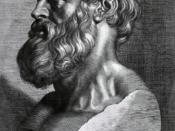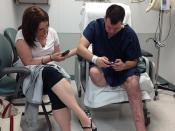Surgery, though crude and painful, did exist in the time of the Renaissance. Early Renaissance surgeons were ignorant of the human body and surgical procedures were almost never successful. They were continuously trying to unveil the mysteries of the body. How and why it functioned, its purposes, and its needs.
Dissections uncovered the most knowledge of the body. However, dissections were rare because they were illegal and very risky. If a surgeon was going to dissect someone he did it at night and in secrecy.
Many admirable surgeons attained their knowledge and experience on the battlefield. They operated on gunshot wounds, inflicted from the primitive firearms used. (Duin et al. 34) Most of the surgeons poured boiling oil into the flesh wounds to get rid of the infection. This crude form of surgery was proven to be obsolescent when Ambroise Pare, a surgeon at the siege of Turin, discovered a more efficient and less painful way to dress wounds.
He used a mixture of egg yolk, rose oil, and turpentine. This method treated patients with less pain, no swelling, and less inflammation than ones treated with boiling oil. (Duin et al. 35)
After religious prohibitions on human dissections and surgical operations were weakened, many discoveries and experiments were made. (WB Encyclopedia 60) The surgeon, teacher, and brilliant anatomist Andreas Versalius was the founder of modern medicine. Before his time, Renaissance doctors continued to follow the methods of the ancient Greeks. They relied mostly on the works and discoveries of Galen, a Greek physician of the 2nd Century AD. He based most of his conclusions about human anatomy from dissections on Barbary Apes. As a student attending the University of Padua, Versalius made his own ideas of the human anatomy. He conducted and performed dozens of dissections, as well as collecting...



Interesting and well written!
Nicely written, easy to read. I like the chronological representation of evolution of surgery. Good job!
0 out of 0 people found this comment useful.